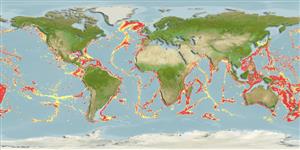Common names from other countries
>
Notacanthiformes (Halosaurs and deep-sea spiny eels) >
Halosauridae (Halosaurs)
Etymology: Aldrovandia: Taken from Ulisse Aldrovandi, (1522-1605), a Renaissance naturalist and physician noted by his systematic and accurate observations of plants and animals (Ref. 45335).
More on author: Günther.
Environment: milieu / climate zone / depth range / distribution range
Ökologie
seewasser benthopelagisch; tiefenbereich 730 - 2560 m (Ref. 3974). Deep-water
Circumglobal, tropical to temperate. Atlantic and Indo-Pacific, except Mediterranean.
Size / Gewicht / Alter
Maturity: Lm ? range ? - ? cm
Max length : 60.0 cm TL Männchen/unbestimmt; (Ref. 41039)
Rückenflossenstacheln (insgesamt): 1; Rückenflossenweichstrahlen (insgesamt): 10-12. Body white to grey-brown in color, underside darker (Ref. 3974). Insertion of the pelvic fin only slightly anterior to the origin of the dorsal fin. Lacks scale on the opercle (Ref. 37108).
Occurs on the middle and lower slope primarily above the 4°C isotherm. Hovers within a few meters of substrate, parallel to it or inclined at varying angles (Ref. 6727). Feeds on polychaetes, pelecypods, amphipods and other benthic prey (Ref. 6727).
Life cycle and mating behavior
Geschlechtsreife | Fortpflanzung | Ablaichen | Eier | Fecundity | Larven
Sulak, K.J., 1990. Halosauridae. p. 126-132. In J.C. Quero, J.C. Hureau, C. Karrer, A. Post and L. Saldanha (eds.) Check-list of the fishes of the eastern tropical Atlantic (CLOFETA). JNICT, Lisbon; SEI, Paris; and UNESCO, Paris. Vol. 1. (Ref. 4448)
IUCN Rote Liste Status (Ref. 130435)
CITES (Ref. 128078)
Not Evaluated
Bedrohung für Menschen
Harmless
Nutzung durch Menschen
Mehr Information
NamenSynonymeMetabolismusRäuberÖkotoxikologieFortpflanzungGeschlechtsreifeAblaichenFecundityEierEientwicklung
PartnerBilderStamps, Coins Misc.LauteCiguateraGeschwindigkeitSchwimmstilKiemenoberflächeOtolithsGehirngrößeSehfähigkeit
Tools
Zusatzinformationen
Download XML
Internet Quellen
Estimates based on models
Preferred temperature (Ref.
115969): 2.5 - 6.6, mean 4 (based on 1890 cells).
Phylogenetic diversity index (Ref.
82804): PD
50 = 0.5156 [Uniqueness, from 0.5 = low to 2.0 = high].
Bayesian length-weight: a=0.00389 (0.00180 - 0.00842), b=3.12 (2.94 - 3.30), in cm Total Length, based on all LWR estimates for this body shape (Ref.
93245).
Trophic level (Ref.
69278): 3.3 ±0.40 se; based on food items.
Widerstandsfähigkeit (Ref.
120179): niedrig, Verdopplung der Population dauert 4,5 - 14 Jahre. (Assuming tmax>10).
Fishing Vulnerability (Ref.
59153): Moderate vulnerability (44 of 100).
